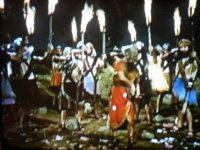I grandi condottieri (Great Leaders of the Bible: Samson and Gideon, 1965)

Of the handful of filmmakers who have made several biblical films, Marcello Baldi is perhaps the most underappreciated. I grandi condottieri, known in the English-speaking world as Samson and Gideon was the last of four films that Baldi made in the early to mid sixties along with I patriarchi (The Patriarchs, 1962) Giacobbe, l’uomo che lottò con dio (Jacob, the Man Who Fought with God, 1963) and Saul e David (1964) (see here for more details).
Here Baldi is only officially credited as the producer, but there's a good deal to suggest he shared at least some of the directing honours with the Spaniard Francisco Perez Dolz. Whilst the first part of the film - dealing with Gideon, was shot in Spain, the second half was shot at Cinecittà in Italy. There are also several moments which feel like Baldi's work elsewhere.
The differences between the two halves of the film, however, extend far beyond filming style. The first stars an affable Ivo Garrani as Gideon (below), but also Fernando Rey as God's messenger. The two form an unlikely friendship. Having delivered his initial message, Rey's character stays on help Gideon slim down his burgeoning volunteer army, advise on strategy and give Gideon the some much needed encouragement. The film has moments of humour (having had to reduce his army still further Gideon quips "I wonder why we don't charge the Midianites, just the two of us") and sees and initially grumpy Gideon become a more relaxed and inspiring leader. As one of only a tiny number of films covering the story of Gideon it's surprising that it goes beyond his initial victory over the Midianites to show him pursuing their leaders until they are captured and killed as well as some of the incidents with his son.
In contrast, the latter part of the film is more self-serious, even including moments of pathos. This section of the film is more typical of the Italian peplum films of this era, specifically the mythical muscleman movies that sprang up following the success of Pietro Francisci's 1958 film Le fatiche di Ercole (Hercules). These supernatural heroes pepla starred characters such as Hercules, Machiste and Goliath, tossed together with those from other historic myths in invented stories. In the ten years following Hercules at least 15 other such films were named after Samson (although on occasion the name of the lead character varied from country to country). The difference with this film however is that it is based on the established story, rather than one made up for the film.

Whereas Gideon remains covered up for the entirety of his section of the film, Samson is frequently shirtless. Whereas God's messenger is present with Gideon almost throughout, in the Samson segment he is experienced only as wind blowing and, perhaps, a voice-over. God doesn't appear again until the end of the film, and, even then, Samson is unable to perceive his presence.
As with the Gideon half of the film, the story sticks reasonably close to the original narratives, whilst still developing the characters a little. Samson (Anton Geesink) has been repeatedly defeating the Philistines's until one day he allows himself to be bound and carried into the Philistine camp, only to wreak victory with the jawbone of an ass. Samson then turns up at Gaza and destroys the gates before the Philistine leaders decide to enlist Delilah (Rosalba Neri) to trap him.
The real strength of the film though is its host of memorable images. Midianites burn Israelite fields as early as scene two. The burning of the Midianite camp, and Garrani's face superimposed over a montage of Israelite victories. In the Gideon section there's a view from the bottom of a well, the moment of realisation when Samson spots the ass' jawbone, shot of the upper echelons of Dagon's temple. All of these testify to Baldi's eye for striking composition.
Sadly though, the lack of a decent copy of the film - the main versions of it available for home viewing are cropped, dubbed and have a very poor quality image - make it hard to appreciate its strengths. Christopher Mulrooney gives it a good go, and makes some interesting observations about two of Baldi's other biblical films, but overall the film gets rather less attention than I think it merits. Perhaps one day Baldi's work (and indeed aht of Baldi/Francisco Perez Dolz) will become fashionable again and his contribution to both the sword and sandal genre and to the Bible on film will be re-evaluated and more widely appreciated.
Labels: Gideon, Italian Bible Films, Judges, Samson



















